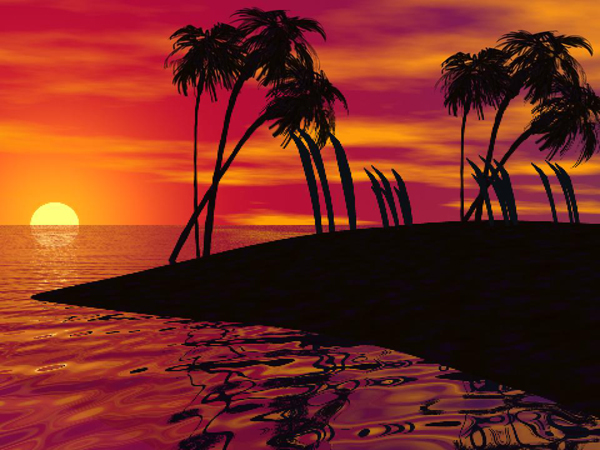Software Review: Bryce
Website: http://www.cimwareukandusa.com
Email: cimware@cimwareukandusa.com

Software Review: Bryce
Website: http://www.cimwareukandusa.com
Email: cimware@cimwareukandusa.com

MetaCreations’ ‘Bryce’ is an extremely versatile program, with a great capacity for a wide range of CGI applications.
As an example, the attached image itself was pieced together using several of the more ubiquitous tools, and a few pre-set choices from the Bryce image inventory (with alterations to each selection).

Considering the sky and lighting effects of the sunset would greatly alter the existing colors of the trees and sand, these were the first groups to model. The Terrain Editor lab was used to create the sand bank shape, silhouetted in the center of the image. The lab itself can be used for either the simplest valley or hill shapes, yet functions like the erode, fracture, and invert can be utilized for the most complex terrain. For this image, the dampen tool was used the most, considering it will be a shoreline.
Once the dimensions and form of the wire frame objects were to satisfaction, the colors and textures were added to each (still keeping in mind to save the more tricky water, cloud, and sky effects to the end). The Materials Lab is an extensive library of pre-created textures ranging from snow and rock, to circuit board, to semi-transparent foliage. However, this lab is not just a library, and any selection can be altered by color, texture concentration, surface, or volume with the Deep Texture Editor. New creations can even be saved into the library for future use. An appropriate sand texture was chosen, and once some choices for trees and grass were added, the shore was finished.
The ‘greenery’ was taken from the Bryce Create Image library. For an animation it would have been impossible to use 3D trees, as the leaves would take forever to render, but for this image the 2D images are indistinguishable from the real thing.
The Water was added next with the Create Water Planes button. Once the water surface was adjusted to the correct Y-axis measurement, a texture would be added from the Materials Lab. Moving an object is usually easiest by manual click and drag from the proper view, but any of the XYZ-axis values can be manually inputted for precision work. Once an appropriate water texture was chosen, the color was altered to fit the scene.
The sky was edited before the clouds, starting with the position of the sun. Although a wire frame sphere could be utilized to represent the sun, it was unnecessary. Bryce allows great control of the weather variables, and the sun was dragged to ground level, and a sky texture was chosen. The SkyLab has quite a few sky textures that could fit any occasion, but a sunset choice from a previous image worked quite well. The colors had been previously altered to fit the position of the sun, and now the sky was finished. Another great function of Bryce is how once one light source is altered, the entire scene changes automatically to fit the realism of the new selection. It can be adjusted manually, but many times this makes life much easier.
The Clouds were entered using the Create Cloud Plane button, and altered the same way as the sky, using the Cloud Cover division of the SkyLab window.
Bryce is, and always will primarily be a scenery program, nevertheless it holds a plethora of options to graphic artists of all skill levels, and all purposes. (The company can be contacted at http://www.metacreations.com).
Review by Richard G. Ranky, Technical Review Editor.
(All trademarks acknowledged).